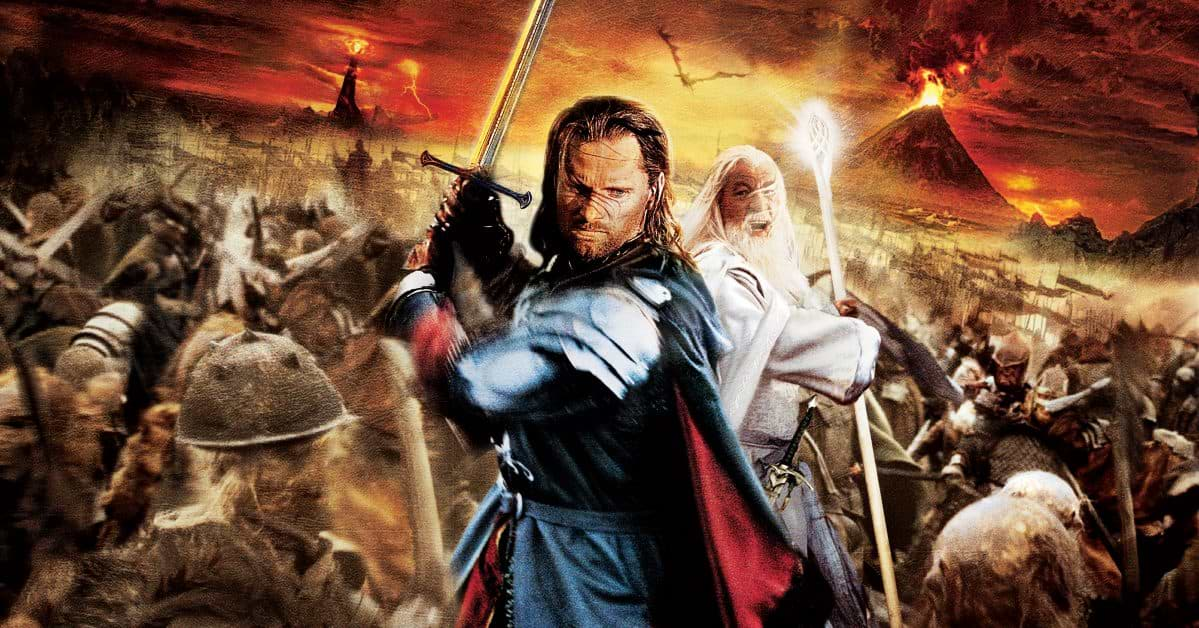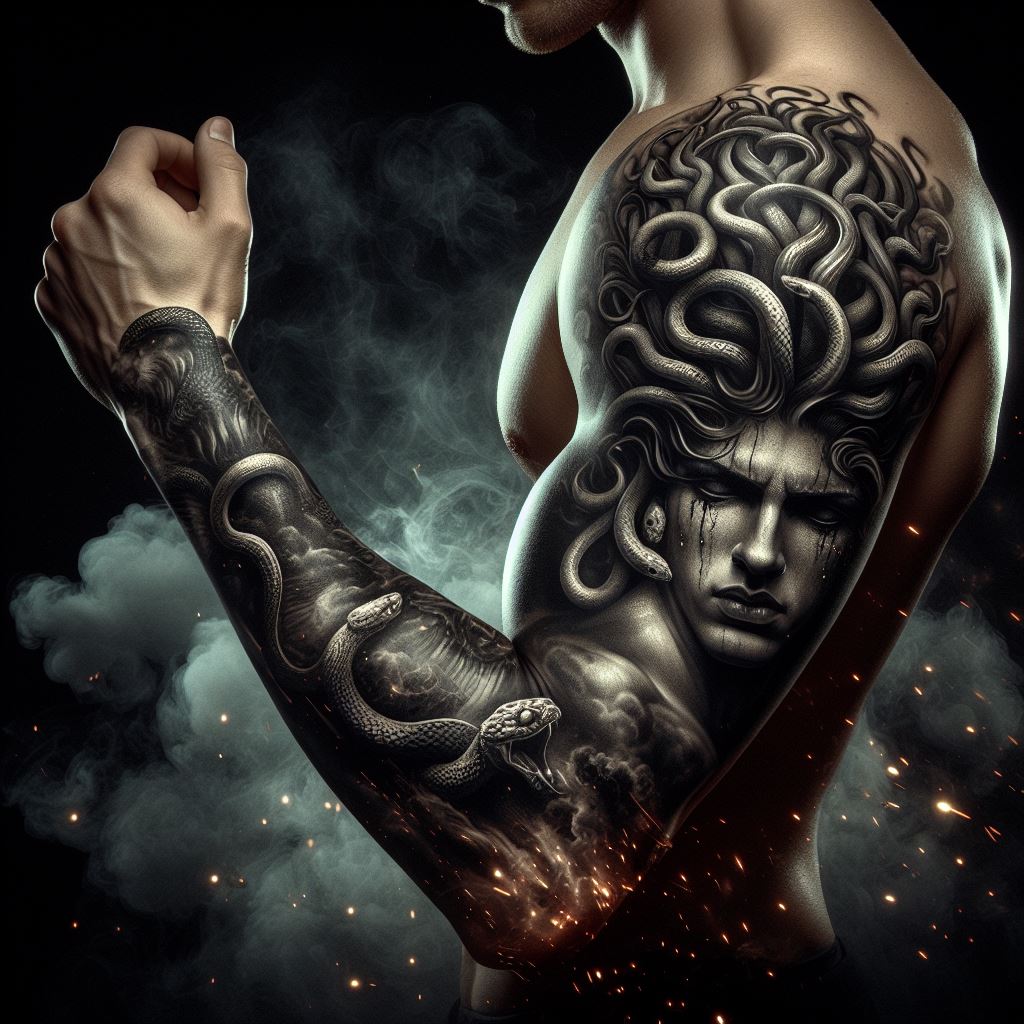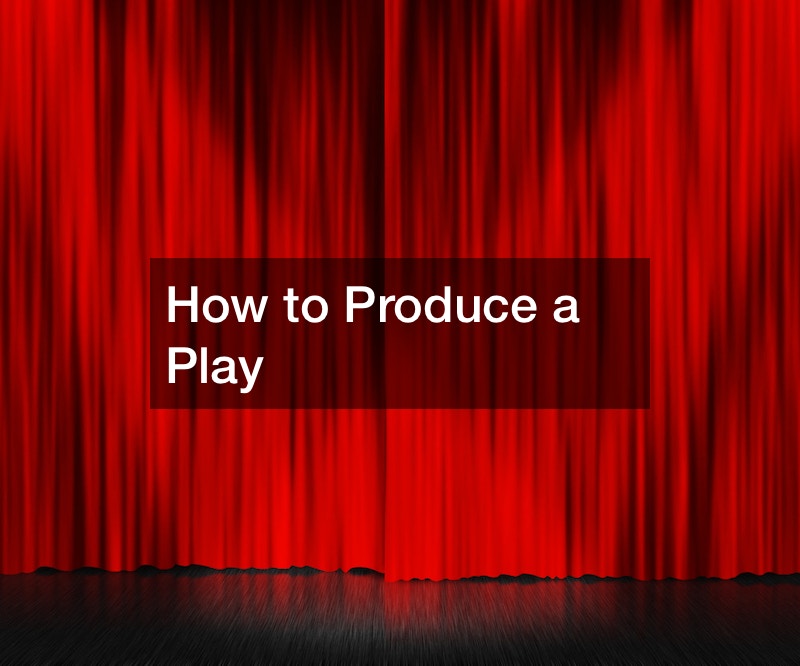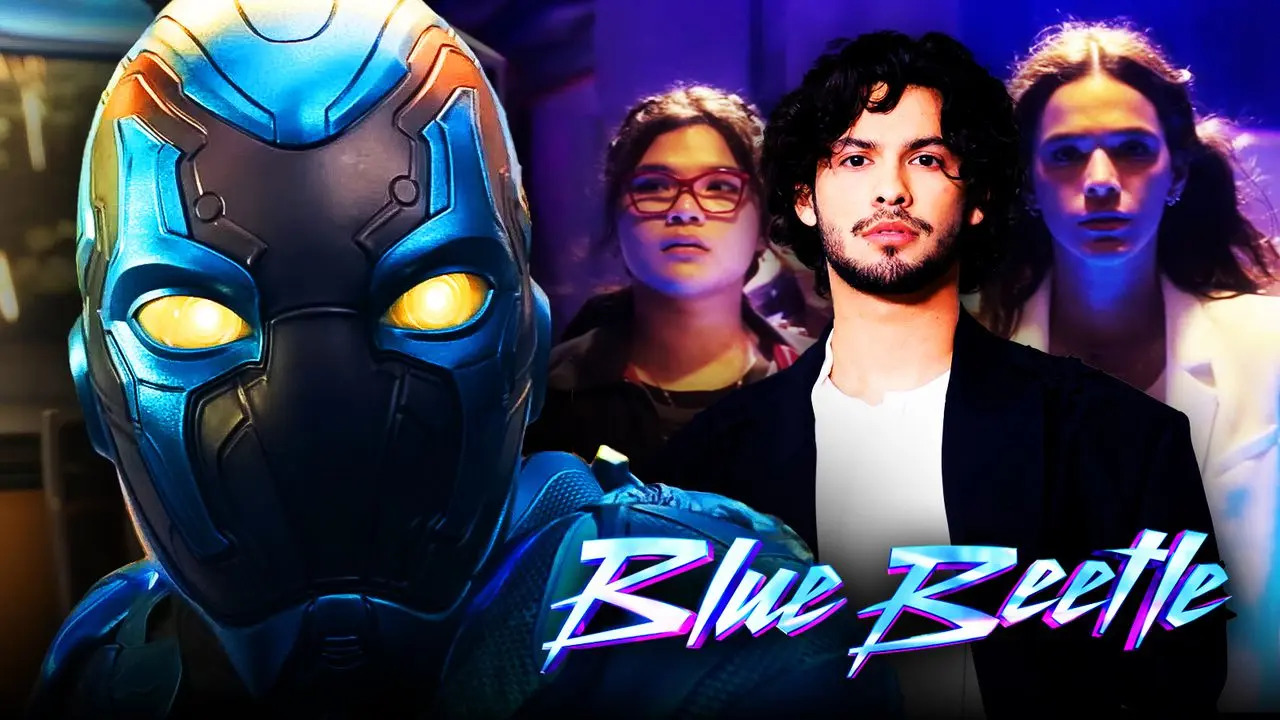Finally, all of the forces of the great War of the Ring are in place: the Fellowship, now split into 4 parties, have all reached their destinations; Pippin and Gandalf arrive at Minas Tirith to rally the city into forming a defence against the incoming Orcish army; Merry, accompanying Éowyn andThéoden King along with the Riders of Rohan, approach Minas Tirith and seek to relieve it from enemy invasion; Frodo and Sam have infiltrated Mordor and are now looking for the best way into Mount Doom; Meanwhile, Aragorn, Legolas, and Gimli have just finished bargaining with the Dead Men of Dunharrow and are now on their way to join the forces of Théoden in Minas Tirith.

If that sounds like a lot is going on, that’s because there is a lot going, and while Peter Jackson did the best he could to try and give each moving part a focus, The Return of the King was overwhelming in terms of scope and scale. Which isn’t necessarily a bad thing: as a whole, the third and final instalment of The Lord of the Rings trilogy delivers in terms of epic battles, a narrative cohesiveness that spans the three movies of the original trilogy and the middle prequels ( which should be viewed in this order, I think), as well as raw, emotional scenes that tie up the whole franchise perfectly.
Grand, sweeping, sophisticated, and completely connects with the audience’s higher functions of nobility and a sense of heroism, the movie as a whole works amazingly well, but zoom in on individual parts and you’ll find little imperfections, scratches on the gears, chinks in the armour. While the second movie suffered from a timid pace that was only rectified by the Battle of Helm’s Deep, the third movie has the exact opposite problem: it had a series of epic scenes that moved at a relatively great pace, but bogged down from time to time by weak, almost meandering scenes. Despite being in a time of what Roger Ebert called “cinematic timidity”, The Return of the King stands out with its bold battles, eloquent dialogue, and superfluous graphics.

But what really sets The Return of the King apart from the other two movies was its perfect balance of story and spectacle. Peter Jackson, by then already a master of using CGI to augment rather than replace special effects, managed to create epic battle scenes and impossible landscapes that toe the line between believability. These couldn’t have been a more perfect backdrop for the narrative which, aside from a few slow scenes, was well-paced and clear enough in its telling. In fact, The Return of the King could be a stand-alone film on its own. Sure, audiences will probably be confused for the first few minutes, but Peter Jackson’s masterful narrative control ensured that, even without any viewing of the previous films, newcomers will still be able to pick up the threads and continue to enjoy. With over 9 hours of movie magic, The Return of the King neatly ties together the Lord of the Rings cinematic universe as tightly and as comprehensive as possible, not an easy feat considering the source!
Picks Up the Pace
Almost all of the plot points in the movie revolve around all actors moving to Minas Tirith, in an epic showdown at Pelennor Fields, where the armies of Mordor are besieging the capital of Gondor. Minas Tirith in itself is a visual masterpiece: a city of stone carved directly on the face of a titanic mountain. Part gleaming capital of the Kingdoms of Men, part impregnable fortress, Minas Tirith was where the Kingdom of Gondor was to make its last stand against the overwhelming forces of Sauron. As Peter Jackson works his camera across, over, and through the city, one can’t help but marvel at the seamless transitions between set, CGI, and location.

Unlike the previous films, the cast of The Lord of the Rings: The Return of the King devotes a large portion of its focus on the Hobbits who, I still believe, are the true heroes of the entire series. In The Return of the King, all the Hobbits are given their chance to shine: obviously, Frodo and Sam are given the almost-impossible task of taking the ring to the fires of Mt. Doom (spoiler alert, they accomplish that), Merry accompanies Éowyn into battle at Pelennor Fields and actually assists in taking down the dreaded Witch-King of Angmar, while Pippin accompanies Gandalf into Mias Tirith to attempt some diplomacy with the ever-so-slightly mad Steward of Gondor (who, by the way, almost burned his own son alive accidentally). Each of the three Hobbit parties showcase their innate, but subtle, heroism: Frodo and Sam trudge on, despite Frodo slowly falling to the temptation of the Ring, Merry rising to the occasion and becoming a full-fledged warrior at the Battle of Pelennor Fields, and Pippin showing his moral fortitude at the face of court politics and cowardice. Even Gollum, despite his corruption, becomes a thing to be pitied rather than reviled, his background as Sméagol giving more gravitas and poignancy to the character.
Stunning Visuals
From legendary action sequences that approach the Battle of Helm’s Deep’s scope and mastery in Lord of the Rings: The Two Towers, to edge-of-your-seat suspense, The Return of the King doesn’t hold back the stunning visuals. With the first two films almost like practice, Peter Jackson masterfully melds CGI with practical effects, using the former only if it complements and elevates the latter, rather than as a replacement altogether. A perfect example of this technique would be in how they animated Gollum: rather than create a CGI monster, Jackson opted to instead shoot Andy Serkis in a special suit to fully capture his range of motion. Couple that with Serkis’ unique approach to the voice of Gollum, and you get one of the most enigmatic characters in the entire series.
In the much touted Battle of Pelennor Fields, Jackson uses the MASSIVE computer program once again to fill in the blanks that the extras left. Yes, that epic battle scene involving a cavalry charge of the Riders of Rohan was shot with thousands of extras riding thousands of horses, with CGI simply adding numbers. While computers were used as a final touch, it’s the human factor in this scene that really takes it into a whole new level.

But even physically impossible scenes, like Aragorn meeting the Army of the Dead at Dunharrow, still involved the use of people. Instead of creating an army of CGI characters, Jackson shot extras in full costume then added a layer of movie magic to give them other-worldly green aura. Even the monstrous Shelob was given terrifying life thanks to a combination of awe-inspiring prop building, acting, and of course, computer image wizardry.
Location, Location, Location
But there’s no substitute for sweeping and panoramic landscapes, and Peter Jackson’s decision to film the entire trilogy in New Zealand wasn’t just a great way for the Kiwi government to get free advertising, it made sense thanks to its stunning and unparalleled beauty. All of the outdoor walking the characters move through, from the Shire and Hobbiton, the valleys of Rivendell, the desolate Gogoroth, and the countless forests, glens, and fields in between, were all real-world locations (spruced up with a bit of CGI, but not by much). Even their indoor scenes were done in New Zealand: sets and other digital scenes were shot at WETA workshop in Wellington, with soundstages being utilized both in Wellington and Queenstown.
Of course, if you visit the real-world locations, you’ll find them to be slightly different: Tongariro National Park and the imposing, but beautiful, Mount Ngauruhoe were chosen to be the setting for most of Mordor and Mount Doom, which is ironic, considering the real-world location has vast and lush grasslands, with Mount Ngauruhoe towering over the landscape with her snowcapped, conical peaks. Visitors can go to Tongariro National Park and even climb Mount Ngauruhoe, if you want relive some key scenes from the movie. It’s a bit of an adventure, but 4×4’s are available for rent in the park, as well as tour guides that will show you where certain scenes were shot.

If you want an easier trip, however, you can visit the Matamata farm, where the Hobbiton scenes were shot. The original sets that Peter Jackson built for the trilogy were disassembled, with any remaining bits and scraps of wood left to naturally decompose (a stipulation in the shooting contract required Jackson and crew to leave their location as well-preserved as possible); however, with the advent of the Hobbit trilogies, the farm owners decided to bring Hobbiton back to life, rebuilding various Hobbit houses to turn into hotels, restaurants, and shops. A great boost to the economy indeed, but also, a great way for die-hard fans to live out their Hobbiton fantasies.

But for me, my favorite location in the entire original trilogy was Edoras, the capital of Rohan and home of the Rohirrim. In real-life, scenes featuring Edoras and its sweeping fields, dramatic ridges, awe-inspiring valleys, and breathtaking vistas were shot in Mount Sunday in the Ashburton district. When I visited last year, I couldn’t help but be awestruck but what I saw, and I imagined hearing the ram horns of the Rohirrim sounding in the distance.
All that beauty, however, wasn’t just for aesthetics; every location fit well with what Peter Jackson was trying to convey in the narrative. Hobbiton, with its gentle hills and rolling plains very much mirrored the Hobbits love for an easygoing life. Rivendell, vast but mysterious in its beauty, clearly represented the Elves and their arcane aura, Edoras and most of Rohan, with its endless fields and beautifully harsh environs, were a reflection of the Rohirrim’s thirst for independence as well as their hardiness. Even Mordor was shown as covered in ash (thanks to the perpetually erupting Mount Doom) and filled with jagged rocks and terrifying lava formations, a clear indication that this place has been corrupted by Sauron’s power.But of course, most of these real-world locations were digitally altered to give them that high fantasy feel, but even without it, the locations Peter Jackson used were simply perfect. If locations could receive an Oscar, then Return of the King should get all those awards.
An Epic Is Born
The Battle of Pelennor Fields, the penultimate battle sequence in the movie, is still one of my favorite scenes in all of movie history. Every moving part in this scene was done so well, you’d think that they actually hired hundreds of thousands of extras, war elephants, and horses, then gave them weapons and told them to have a great day.

It’s so natural and the acting so visceral that you can’t help but feel emotional with every triumphant battle cry, every sword swing, and every wound received. This, my friends, is how you do epics: creating a scene where there are hundreds of thousands of people, yet still managing to laser focus on the human drama within the chaos. A good epic should stand on its own; take away the CGI Orcs, the swords, even the intricate battle armor, and you’re still left with a compelling, emotional, and gripping drama that touches on the highest ideals of humanity: nobility of spirit, bravery, fortitude, and grace.
And this is where The Lord of the Rings: The Return of the King and The Hobbit: The Battle of the Five Armies differ: The Battle of the Five Armies set out to become a blockbuster movie, while Return of the King set out to become a modern-day epic, a 21st century piece of legend that masterfully blended visual spectacle with narrative wonder. Truly, Peter Jackson was not only able to bring to life and bring honor to J.R.R. Tolkien’s masterpiece, he created a masterpiece of his own: an audiovisual epic unlike any other that, nearly 20 years after it concluded, has stood the test of time, and gets better and better with every re-watch.





